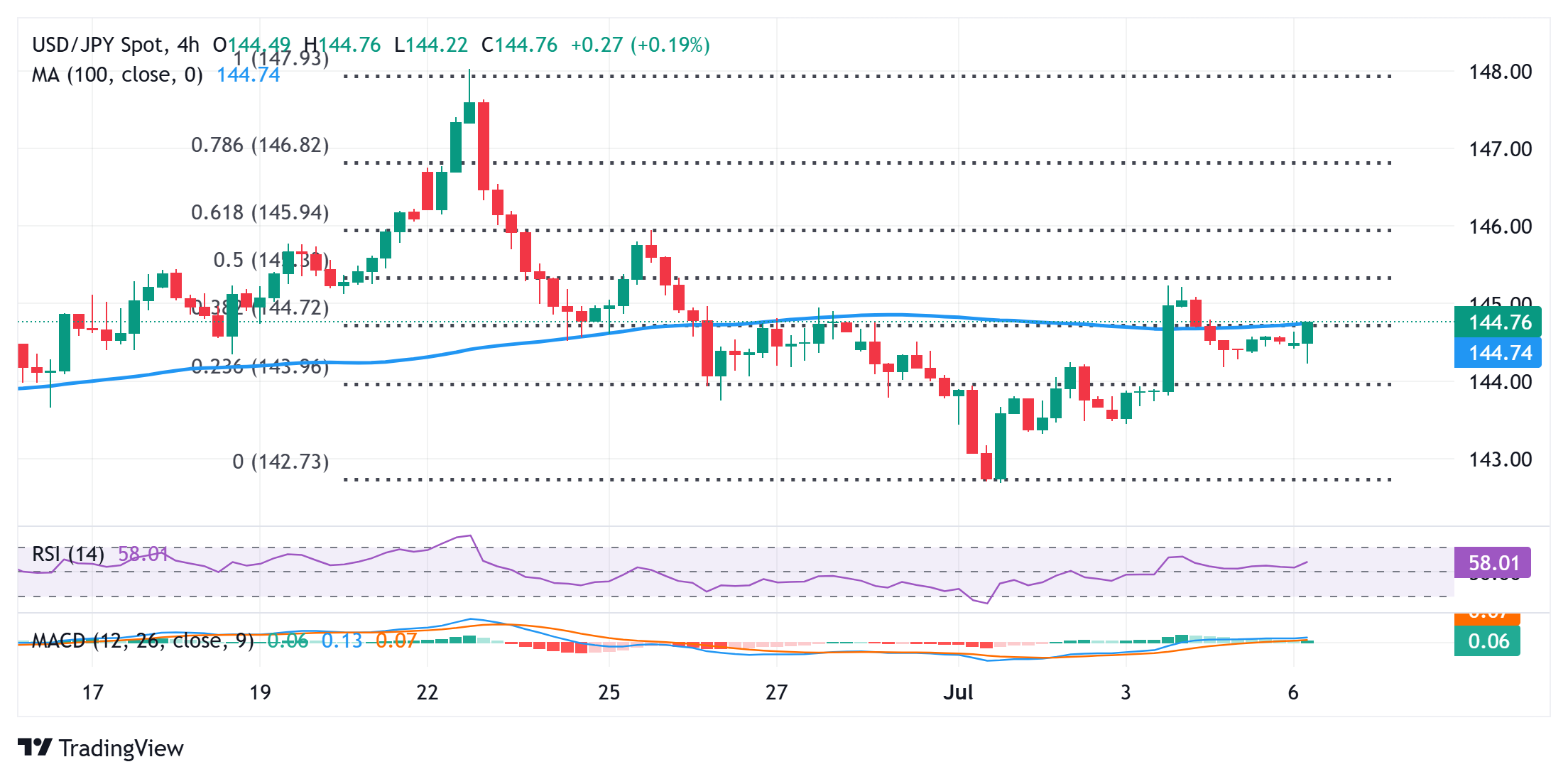- The Japanese Yen drifts lower in reaction to weaker domestic wage growth data.
- Geopolitical risks and divergent BoJ-Fed expectations should limit JPY losses.
- The USD bearish sentiment might further contribute to capping the USD/JPY pair.
The Japanese Yen (JPY) continues with its relative underperformance against a broadly stronger US Dollar (USD), pushing the USD/JPY pair back above the 145.00 psychological mark during the Asian session. Investors remain worried about the potential economic fallout from steep US tariffs, especially after President Donald Trump threatened last week to impose more levies on Japan over its alleged unwillingness to buy American-grown rice. This, in turn, could squeeze corporate profits and potentially undermine future wage growth, which could complicate the Bank of Japan’s (BoJ) monetary policy normalization schedule and undermine the JPY.
Meanwhile, data released earlier today showed that real wages in Japan fell for the fifth straight month in May, at the fastest pace in nearly two years. This turns out to be another factor exerting downward pressure on the JPY. Despite the negative factors, any further JPY depreciation seems elusive in the wake of the growing acceptance that the BoJ will hike interest rates again. In contrast, the Federal Reserve (Fed) is expected to resume its rate-cutting cycle in the near future, which might cap the upside for the USD and lend support to the lower-yielding JPY. Hence, any subsequent move up in the USD/JPY pair might still be seen as a selling opportunity.
Japanese Yen bears retain intraday control; BoJ rate hike bets warrant caution
- The Israeli military carried out intense strikes on Houthi targets in three Yemeni ports and a power plant early this Monday in response to repeated attacks by the Iran-aligned group on Israel. This marks the first Israeli attack on Yemen in almost a month and should drive safe-haven flows towards the Japanese Yen.
- Government data released earlier today showed that Nominal Wages in Japan rose 1% in May 2025 from a year earlier, marking the third straight month of deceleration and falling well short of market expectations. This was also the weakest growth since March 2024 amid an 18.7% plunge in special bonus payments.
- Adding to this, inflation-adjusted real wages posted the steepest decline in 20 months and fell 2.9% YoY in May compared to a revised 2.0% drop in the previous month. Meanwhile, the consumer inflation rate that the labour ministry uses to calculate real wages climbed 4.0% YoY during the reported month.
- The data fueled concerns that stagnant real incomes could dampen consumer spending and stall broader economic recovery amid heightened uncertainty over US President Donald Trump’s new tariffs. This might complicate the Bank of Japan’s path to normalising interest rates and capping gains for the JPY.
- The US Dollar, on the other hand, struggles to register any meaningful recovery from a multi-year low touched last week amid relatively dovish Federal Reserve expectations. In fact, traders are pricing in over a 70% chance of a rate cut in September and at least two 25 basis points rate reductions this year.
- Investors now look forward to the release of the FOMC meeting minutes on Wednesday for fresh cues about the Fed’s policy outlook and rate-cut path. This, in turn, will play a key role in influencing the near-term USD price dynamics and providing some meaningful impetus to the USD/JPY pair.
USD/JPY could extend the intraday move up towards the 145.25-145.30 supply zone

Momentum beyond the 144.65-144.70 confluence – comprising the 100-period Simple Moving Average (SMA) on the 4-hour chart and the 38.2% Fibonacci retracement level of the June-July downfall – would be seen as a key trigger for the USD/JPY bulls. The subsequent move up could allow spot prices to reclaim the 145.00 psychological mark and test the 145.25-145.30 supply zone. A sustained strength beyond the latter should pave the way towards the 61.8% Fibo. retracement level, around the 146.00 round figure.
On the flip side, the Asian session low, around the 144.20 horizontal zone, could offer some support ahead of the 144.00 round figure, or the 23.6% Fibo. retracement level. A convincing break below might shift the bias back in favor of bearish traders and drag the USD/JPY pair to the 143.45 intermediate support en route to the 143.00 mark. The downward trajectory could extend further towards the 142.70-142.65 region, or a one-month low touched last Tuesday.
US Dollar PRICE Today
The table below shows the percentage change of US Dollar (USD) against listed major currencies today. US Dollar was the strongest against the New Zealand Dollar.
| USD | EUR | GBP | JPY | CAD | AUD | NZD | CHF | |
|---|---|---|---|---|---|---|---|---|
| USD | 0.15% | 0.30% | 0.59% | 0.32% | 0.87% | 0.88% | 0.21% | |
| EUR | -0.15% | 0.17% | 0.22% | 0.15% | 0.79% | 0.73% | 0.05% | |
| GBP | -0.30% | -0.17% | 0.02% | 0.00% | 0.63% | 0.57% | -0.23% | |
| JPY | -0.59% | -0.22% | -0.02% | -0.07% | 0.47% | 0.48% | -0.35% | |
| CAD | -0.32% | -0.15% | -0.00% | 0.07% | 0.57% | 0.57% | -0.24% | |
| AUD | -0.87% | -0.79% | -0.63% | -0.47% | -0.57% | 0.04% | -0.85% | |
| NZD | -0.88% | -0.73% | -0.57% | -0.48% | -0.57% | -0.04% | -0.80% | |
| CHF | -0.21% | -0.05% | 0.23% | 0.35% | 0.24% | 0.85% | 0.80% |
The heat map shows percentage changes of major currencies against each other. The base currency is picked from the left column, while the quote currency is picked from the top row. For example, if you pick the US Dollar from the left column and move along the horizontal line to the Japanese Yen, the percentage change displayed in the box will represent USD (base)/JPY (quote).

